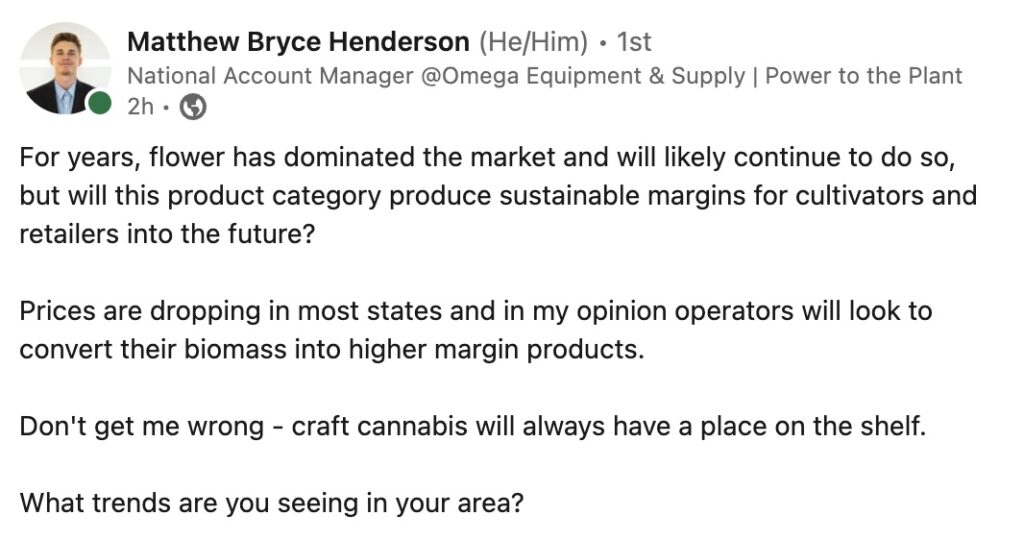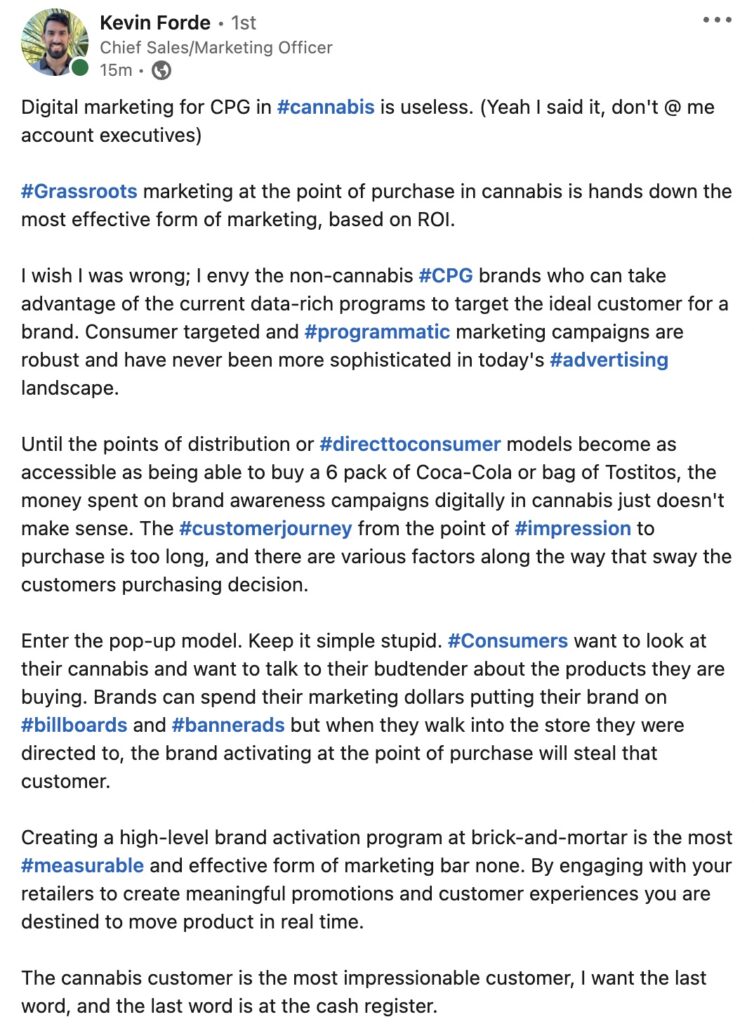16 August 2022 | Cannabis
What does in-person activation look like for cannabis brands?
By Kaitlin Domangue
Wholesale flower prices are dropping – is the product category losing steam?

TLDR: Wholesale flower prices are dropping in most states.
There are several reasons for this, here are two:
1. Market maturation
Demand outweighs the supply when states first come online.
There are limited retailers, cultivators, and products. Everyone’s buzzing about the new industry and buying legal cannabis.
By year 3 of a new market, things begin to even out. Supply begins to outweigh the demand. Operations with little financial resources and poor processes begin to fizzle out and ultimately, fail out of the market completely.
2. COVID-19
I look forward to a day when COVID-19 is not a reason for things being the way they are, but I fear I’ll never see that day in my lifetime 🤷♀️
Anyways… consumers purchased a lot of cannabis in 2020.
Stay-at-home orders were in effect, people were working from home, and anxieties were high (pun not intended, but I’m rolling with it). It was a good time for cannabis sales.
Fast forward to 2021. Vaccines hit the market, unemployment and stimulus checks aren’t coming, and stay-at-home orders are lifted.
And that’s where we’re at now. Less demand = dropping flower prices.
3. Other factors
The wildfires on the West Coast have impacted the cannabis supply chain and disrupted wholesale prices.
And in states like Colorado, surrounding states are beginning to pass legislation. Colorado was raking in the tourism cash for a few years being one of the only recreational cannabis states in the country, but that’s all changing quickly – removing Colorado’s unique appeal and dropping the price of wholesale flower.
What I’m Thinking 🧠
I think flower will always be a major player. If you would have asked me six months ago, I would have said flower will always be the top-selling product category.
Now, I’m not so sure. If I’ve learned anything from working in this market, it’s that we never know what’s going to happen next – like my opinion changing every six months 🙂
Cannabis consumers are experimental and constantly changing – flower might not be the #1 category in 10 years. But, I totally agree with Matthew about craft cannabis brands: they’ll always have a place on the shelf.
And as time goes on, I only expect craft cannabis brands to grow even more. At the heart of it, craft cannabis is about small, local operations and 93% of consumers say shopping small is more important than ever.
I also agree that operators might be looking to shift gears and turn biomass into higher selling products, but I don’t foresee that happening on a massive scale with existing operators.
Pre-rolls are growing quickly, but consumers usually want ground whole flower, which not every brand is willing to give.
In preparation for the anticipated & continual decline of flower prices – now is the time for alternative product categories and brands to lean into themselves and define who they are. It’s the time to work out kinks in your recipes and find your target audience.
In the next 3 years, I anticipate other product categories to explode in ways we haven’t seen yet. The brands who know their audience and what they’re going for will be the ones to succeed.
Is digital marketing dead for cannabis CPG?

TLDR: In-person activation strategies are more effective than digital marketing for cannabis brands.
My guess is that *most* cannabis brands solely rely on digital marketing for growth, but like Kevin said: the cannabis customer’s journey isn’t streamlined enough yet to neglect in-person activation strategies.
And, this post is right on time. I got a really interesting email from a subscriber the other day sharing the results of a recent budtender survey. The findings?
Nearly 90% of those surveyed said brands are NOT offering enough engaging budtender events. 84% of those surveyed said facility tours, product sampling, and educational seminars are all great ways brands can engage with budtenders.
Budtenders are the direct line to consumers. Make a budtender love your brand and you’ve got a loyal salesman for life, no matter which retailer they work at. Budtender events are a fantastic way to bring in-person engagement to life.
I asked Kevin (the post’s author) the most effective brand activation strategies he’s seen so far. He said:
“The ones who demonstrate the 3 out of 5 P’s. People, Process, Promotion.
People – You need people who are engaging to sell. Don’t just give a stack of stickers and a t-shirt to the first “ambassador” you can find.
Process – There is a science to engaging with an impressionable customer. Your approach and pitch is the key.
Promotion – Whether you are discounting the product or giving away swag for purchase, giving the customer an incentive.”
The survey captured some answers from budtenders about in-person events. Here are some of the most interesting ones:
“Cheeba Chews provided us with a first-time event,” a budtender writes in the survey. “Ten budtenders were able to tour the facility, provide feedback in a comfortable environment, and see how Cheeba Chews are made. We also tested non-infused samples of their new MELTS line before they hit the market. They even sent us home with a box full of epic swag and samples!”
I don’t believe digital marketing in cannabis is useless at all for CPG brands.
I do think that CPG brands would be silly to not focus on in-person activation strategies like Kevin talked about. The cannabis customer’s journey isn’t streamlined, but it’s not offline.
Utilizing in-person activation strategies that incorporate digital media is a great way to bring both to life, like scanning a QR code to join the brand’s newsletter and get 10% off.
Even if the two efforts have nothing to do with each other, ignoring digital marketing strategies in favor of devoting your time on in-person strategies will lose customers during the journey.
But ignoring in-person strategies in favor of digital ones will also guarantee you lose customers. It is an extremely important approach for cannabis brands, especially small ones that are mostly hyperlocal.
Combining both and paying close attention to every phase of the buyer’s journey is the best way for cannabis brands to cover all of their bases and engage with as many customers as possible.